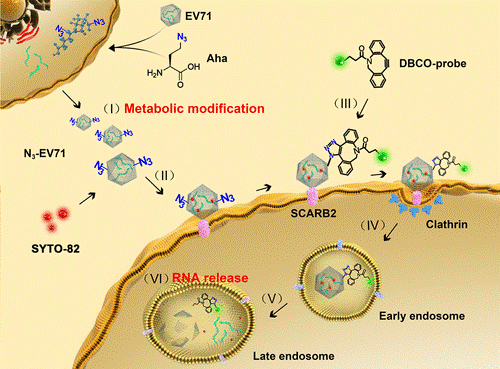Scientists Develop Reliable Viral Labeling Strategy for Visualization of Ev71 Infection
Date:25-03-2020 | 【Print】 【close】
Research groups from Shenzhen Institutes of Advanced Technology, Chinese Academy of Sciences, developed a novel virus labeling strategy, utilized protein biosynthesis for dynamic visualization of nonenveloped enterovirus 71 infection, which could help scientists reveal viral infection mechanism and develop antiviral drug for children at great risk of the infection disease.
The study has been published in ACS Applied Materials & Interfaces.
Enterovirus 71 (EV71), a major cause of severe hand foot-and-mouth diseases (HFMD), can progress to serious and life-threatening neurological complications, such as brainstem encephalitis, meningitis, and poliomyelitis-like paralysis. Understanding the viral invasion pathway of EV71 is highly desirable for elucidating its pathogenesis.
Although genetic engineering and chemical coupling have been applied to track viral infection in host cells and in vivo. However, these strategies could potentially interfere with viral invasive pathways. Understanding the viral invasion pathway of EV71 is highly desirable for elucidating its pathogenesis and developing antiviral drugs, as they say.
The research team developed a reliable viral labeling strategy based on protein biosynthesis for precisely dissecting the invasive pathway of EV71, especially clarified the process of viral RNA uncoating.
They found that L-azidohomoalanine (Aha), an azido derivative of methionine, was more effective than azido sugars to introduce azido motifs into viral capsid proteins by substituting methionine residues during viral protein biosynthesis and assembly.
"The azide-modified EV71 (N3-EV71) particles are then effectively labeled with dibenzocyclooctyl (DBCO)-functionalized fluorescence probes through an in situ bioorthogonal reaction with well-preserved viral infectivity.” Professor CAI said.
"The dual-labeled imaging clearly clarifies that EV71 virions primarily bind to scavenger receptors and are internalized through clathrin-mediated endocytosis. The viral particles are then transported into early and late endosomes where viral RNA is released in a low-pH dependent manner at about 70 min post infection.”
The research is an important milestone in the study of enterovirus infection, they clearly showed clathrin-mediated endocytosis and uncoating processes of EV71, especially the spatio-temporal dynamics of the virus infection in host cells. These findings may play an important role on revealing the invasion route and pathogenesis of EV71 infection.
"By using this strategy, we dynamically visualized the invasive pathway of EV71, including viral entry, intracellular transportation, and virus uncoating, which filled a critical gap in knowledge about EV71 RNA release. These results may shed light on the pathogenesis of EV71 infection and contribute to antiviral drug discovery.” Professor CAI concluded.

Schematic illustration of bioorthogonal metabolic strategy based on protein biosynthesis for nonenveloped EV71 labeling and tracking (Image by SIAT)
Media Contact:
ZHANG Xiaomin
Email: xm.zhang@siat.ac.cn
Tel: 86-755-86585299